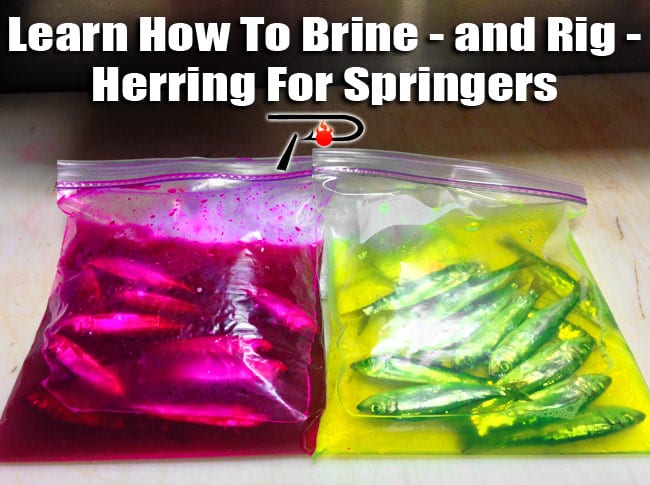Spawn
Learn How To Brine & Rig Herring For Springers
By Bill Swann | 04/23/2014
When springer fishing there’s nothing that reflects more on success than having good herring. Before diving into how we fish herring let’s touch on why they are so effective. The importance of herring in our springer fishery revolves around herring’s oils. Spring Chinook (and other salmon) feed on herring in the ocean.
Meanwhile, once the spring Chinook enter the river system there’s no more herring available in the estuaries and rivers. At this point the salmon switch over to eating anchovies, which are available in the estuaries of the Pacific Northwest. However,
this ultimately means that spring Chinook crave fresh herring and those who have it catch more fish.
(Above) Herring brined in Natural Fire Brine
The importance of having good, quality, fresh herring is vital to catching spring Chinook. By good herring I mean the scales are in tact and the herring have been starved in net pens for two or more weeks (to get the optimal amount of herring oil from the fish). The best quality herring you can buy is Puget Sound herring. It’s this simple: have great herring and you’ll catch more fish.
When you use herring right out of the bag it does work well. However, they don’t last long because they turn to mush quickly. If you use them right out of the bag you’ll end up going through a lot of bait and spending more than you want. By brining and or curing your herring it lasts longer and you can use them for days to come. It also toughens them up and makes them more durable.
Brining herring is very simple. Homemade brines are a thing of the past. If you use Pautzke Fire Brine, like I do, all the work is done for you. Basically, you get a Gallon Ziploc, thaw your herring enough to where they are semi-thawed and place them in the bag. Then pour in your Fire Brine color of choice (Natural, Green, Blue, Chartreuse are most common), zip it closed with air in the bag and either keep it in the fridge or on ice. In 12 hours they are done and ready to fish. Yes, it’s that simple.
I always come to the river with natural, blue and chartreuse brined herring and commonly use red and other colors too. Being able to fish multiple rods I use several colors and let the fish tell me what they want on that day. For example, today was blue, but natural has been working the best so far this season.
On the other hand, you need to come with an assortment of colors because the bite can change any minute. Some guys will even use red and purple. In fact, green is very popular, but many people don’t stray and use these colors because they aren’t talked about much. Conversely, on a sunny, clear day red is phenomenal.
Rigging herring is extremely important to get proper spin. Having them rigged correctly dictates success. You want your herring to spin rather than wobble. It’s a tough thing to describe, which is why I’ve added a photo to detail the proper rigging.
Editor’s Note: The techniques described above by Swanny can be applied to any fishery where salmon are present. This includes the West Coast and Great Lakes. For more info on Swanny’s Guide Service please visit www.swannysfishing.com.[/fusion_builder_column][/fusion_builder_row][/fusion_builder_container]












